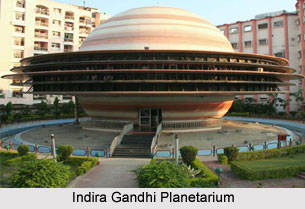 Indira Gandhi Planetarium which is a novel attraction of the Lucknow city is located at the banks of Gomti River. It is named after senior Indian National Congress leader and former Prime Minister of India Indira Gandhi. The stunning Saturn shaped building is exceptional in the world. The planetarium reveals the wonderland and beauty of Astronomy. Astounding distances from outer space are also eliminated. Indira Gandhi Planetarium is a popular destination for tourists.
Indira Gandhi Planetarium which is a novel attraction of the Lucknow city is located at the banks of Gomti River. It is named after senior Indian National Congress leader and former Prime Minister of India Indira Gandhi. The stunning Saturn shaped building is exceptional in the world. The planetarium reveals the wonderland and beauty of Astronomy. Astounding distances from outer space are also eliminated. Indira Gandhi Planetarium is a popular destination for tourists.
Foundation of Indira Gandhi Planetarium
The foundation stone of this beautiful building of Saturn shape was laid on 28th February, 1988 by the Chief Minister of Uttar Pradesh Honourable Late Veer Bahadur Singh. This place was inaugurated on 8th May, 2003 by the former Chief Minister of Uttar Pradesh, Ms. Mayawati. From 9th May 2003 the Planetarium has been opened for public viewing.
Structure of Indira Gandhi Planetarium
The entire structure of Indira Gandhi Planetarium is in unique shape of Saturn with five rings. The 21 meter diameter spherical building of the planetarium rest on platform is especially designed to give an idea of crater formation on celestial bodies. The platform is surrounded by water pool with fountains.
Reason behind the Construction of Indira Gandhi Planetarium
The Government of Uttar Pradesh has established a Planetarium at Lucknow with following objective:
•To provide basic information on different aspects of astronomy through planetarium shows exhibits.
•To popularise Science.
•To establish the amateur club and provide guidance to amateur astronomer and interested students.
•To arrange astronomical exhibition, quiz and art competitions for children and common men.
Shows at Indira Gandhi Planetarium
In the Indira Gandhi Planetarium, one can virtually touch the stars, "Journey through Jungles of Stars" and see many other celestial events in a matter of minutes that in reality take months, years or million of years to happen. The planetarium has regular film shows with duration of 40 mins on subjects related to astronomy. It also holds exhibitions, which attracts lots of visitors. It remains closed on Monday.
This article is a stub. You can enrich by adding more information to it. Send your Write Up to content@indianetzone.com



















